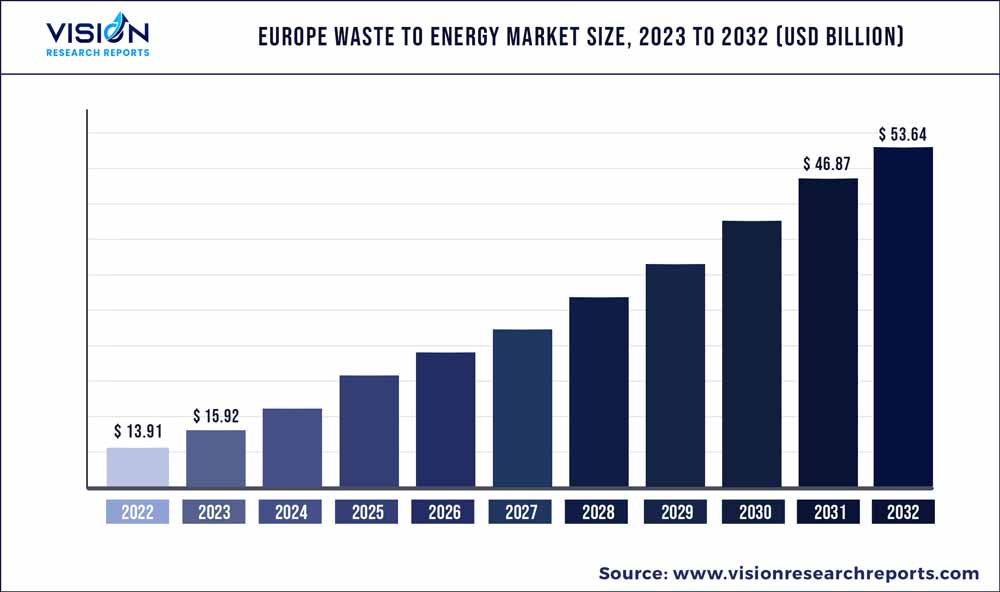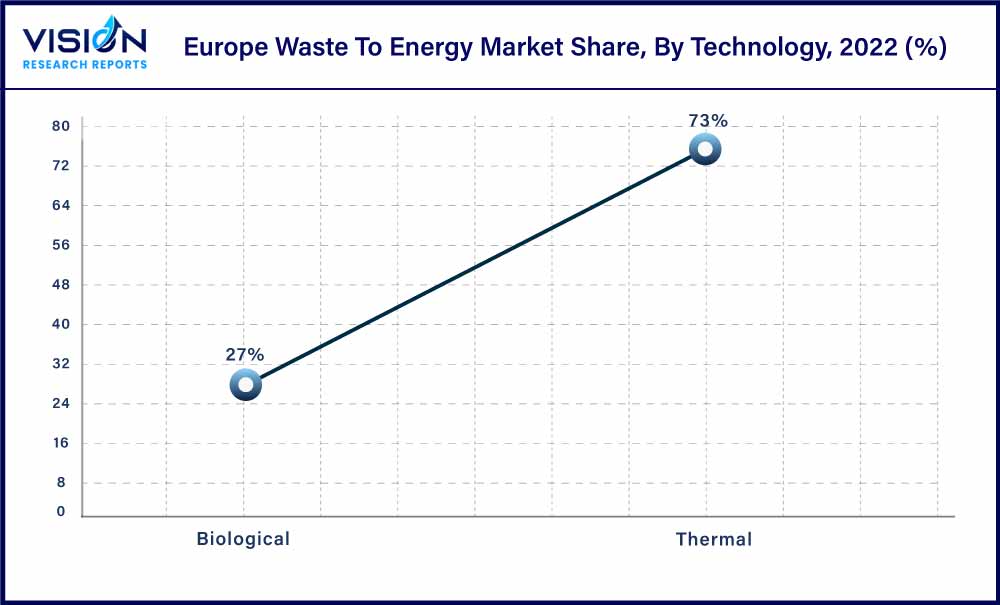The Europe waste to energy market was surpassed at USD 13.91 billion in 2022 and is expected to hit around USD 53.64 billion by 2032, growing at a CAGR of 14.45% from 2023 to 2032.

Key Pointers
Report Scope of the Europe Waste To Energy Market
| Report Coverage | Details |
| Market Size in 2022 | USD 13.91 billion |
| Revenue Forecast by 2032 | USD 53.64 billion |
| Growth rate from 2023 to 2032 | CAGR of 14.45% |
| Base Year | 2022 |
| Forecast Period | 2023 to 2032 |
| Market Analysis (Terms Used) | Value (US$ Million/Billion) or (Volume/Units) |
| Companies Covered | SUEZ;Hitachi Zosen Inova AG; Veolia; Martin GmbH; Mitsubishi Heavy Industries Ltd; Ramboll Group A/S; STEAG energy services Gmbh; Wheelabrator Technologies; EEW Energy from Waste; Tana Oy |
The market is projected to grow significantly owing to the growing distress about GHG emissions and new EU regulations to decrease carbon footprint. Growing environmental concerns and climate change have led various countries around the world to take steps to reduce their carbon footprint from the industrial sector and opt for waste to energy technology.
As per the EU - Central Asia Cooperation on water environment and climate change, the share of waste disposal in the EU has increased from more than 16% in 2000 to 27% in 2020. A growing share of waste disposal in Europe is expected to drive the European waste to energy (WTE) market over the forecast period.
Due to the Russia-Ukraine conflict, prices of natural gas inflated in the region which fueled the government to enact other sources of energy generation. Favorable regulations like the windfall tax which was implemented in November 2022 consist of an additional 45% levy on generators. This tax covers electricity generated by anaerobic digestion plants or waste to energy facilities. Hence, this supports additional energy from waste facilities which are expected to augment the growth of the market in the region.
Fossil fuels account for over 60% share in the electricity generation sector around the world. However, with the rise in environmental concerns, there has been an increase in the adoption of renewable energy. The presence of stringent environmental regulations and policies in majority of the European countries has also provided a major boost for renewable energy.
The power generation market has been witnessing a surge in the installed capacity of renewable power sources on account of growing environmental concerns coupled with the aim to reduce the harmful effects of greenhouse gasses in majority of the countries. This has been a major factor in the expansion of waste to energy in Europe.
Germany’s economy is led by the industrial manufacturing sector, including fabricated parts and metal components. East Germany is marked with significant metal forging, stamping, and bending processors & facilities. The food & beverage processing sector also has a major presence, contributing to a considerable amount of organic and non-hazardous waste generated across the country.
Thermal technology dominated the waste-to-energy market in 2022 and is expected to maintain its dominance owing to the increasing development in gasification and incineration technologies in Germany.
In November 2016, Climate Action Plan 2050 was adopted by the government of Germany. Germany became the first among the Paris Agreement participants to submit a low GHG emission development strategy to the United Nations. The plan was designed to achieve the country's goals and targets pledged in the Paris Agreement, intending to achieve global greenhouse gas neutrality by 2050. One of Germany's major long-term goals is to become a neutral nation in terms of greenhouse gas emissions by 2025.
Hence, favorable government policies and low emission goals are expected to foster a waste to energy market in the country over the forecast period.
Technology Insights
Based on technology, the Europe waste-to-energy market has been segmented into biological and thermal. The thermal type segment is further sub-segmented into incineration, gasification, and pyrolysis. Thermal technology accounted for the largest revenue market share of 73% which includes waste that is subjected to high temperatures but with different oxygen concentrations. Biological includes anaerobic digestion. Biological treatments are used with wet waste such as food waste and farm slurry.

Biological includes anaerobic digestion. Biological treatments are used with wet waste such as food waste and farm slurry. The growth of biological waste-to-energy technology is attributed to the gradual development of anaerobic decomposition technology. Governing authorities of various developed nations indulge in several research & development activities to improve the economic feasibility of anaerobic digestion facilities. Advancements in reactor design and genetic engineering of organisms are among the vital factors that are critical to the enhancement of biological conversion of gases to fuels and other co-products. Concerns related to the environment and the rising demand for clean fuels such as biogas in the transportation sector are anticipated to boost the segment growth.
Europe Waste To Energy Market Segmentations:
By Technology
 Cross-segment Market Size and Analysis for
Mentioned Segments
Cross-segment Market Size and Analysis for
Mentioned Segments
 Additional Company Profiles (Upto 5 With No Cost)
Additional Company Profiles (Upto 5 With No Cost)
 Additional Countries (Apart From Mentioned Countries)
Additional Countries (Apart From Mentioned Countries)
 Country/Region-specific Report
Country/Region-specific Report
 Go To Market Strategy
Go To Market Strategy
 Region Specific Market Dynamics
Region Specific Market Dynamics Region Level Market Share
Region Level Market Share Import Export Analysis
Import Export Analysis Production Analysis
Production Analysis Others
Others